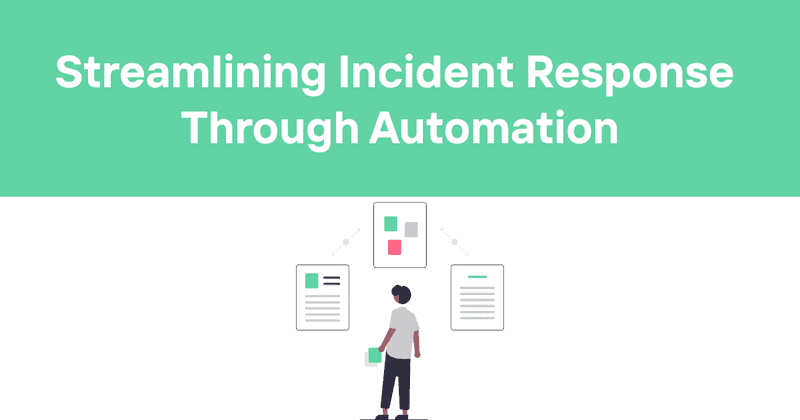Streamlining Incident Response Through Automation
When disaster strikes your production environment, every second counts. I've seen too many teams scrambling in the middle of the night, bleary-eyed engineers desperately hunting through logs while customers flood your support channels with complaints. Been there, done that.
Incident response automation isn't just a nice-to-have anymore—it's become essential for any team running critical services. Let's dive into what works, what doesn't, and how to implement automation that actually makes your life easier during those 2 AM fire drills.
Table of contents
- What is incident response automation?
- Benefits of automating incident response
- Key components of an automated incident response system
- How incident response automation works
- Best practices for implementing automation
- Common automation use cases
- Tools for incident response automation
- Challenges and pitfalls
- Balancing automation with human intervention
- Measuring automation effectiveness
- Odown: Enhance your incident response with reliable monitoring
What is incident response automation?
Incident response automation uses technology to detect, analyze, and remediate incidents with minimal human intervention. Think of it as your first line of defense—handling routine tasks so your human engineers can focus on complex problems that require their expertise.
At its core, incident response automation consists of predefined rules, scripts, and workflows that kick in when monitoring systems detect anomalies. These automated responses can range from simple notifications to sophisticated remediation actions like restarting services, rolling back deployments, or isolating affected systems.
The goal isn't to replace human responders but to augment them. By automating repetitive tasks, teams can:
- React faster to incidents
- Provide consistent responses regardless of who's on call
- Reduce the cognitive load on engineers during high-stress situations
- Create reliable documentation of incident timelines
Benefits of automating incident response
Implementing automation in your incident response workflow delivers tangible benefits that directly impact both your technical team and business outcomes:
Dramatically reduced response times
Manual incident response typically follows this pattern: alert → notification → engineer acknowledgment → investigation → remediation. This process can take anywhere from minutes to hours.
With automation, the system can immediately execute predefined actions upon alert detection. I've seen teams cut their MTTR (Mean Time to Resolution) by 70% after implementing basic automation for common failure scenarios.
Reduced alert fatigue
Alert fatigue is real. When engineers are bombarded with notifications, they become desensitized to alerts and might miss critical issues. Automation helps by:
- Filtering out false positives
- Handling routine issues automatically
- Aggregating related alerts
- Only escalating issues that truly need human attention
One DevOps team I worked with reduced their midnight pages by 60% after implementing intelligent alert filtering and automated remediation for common problems like disk space issues and service restarts.
Consistency in responses
Humans are inconsistent. We make different decisions based on fatigue, experience level, and personal preferences. Automated responses follow the same playbook every time, ensuring:
- Standard remediation steps
- Proper documentation
- Consistent communication to stakeholders
- Adherence to compliance requirements
Improved team morale
Let's be honest—no one enjoys being woken up at 3 AM for an issue that could have been resolved automatically. By handling routine problems, automation:
- Reduces on-call burden
- Allows engineers to focus on interesting problems
- Decreases burnout
- Improves work-life balance
Key components of an automated incident response system
A robust incident response automation system typically includes these essential components:
Monitoring and detection
Everything starts with visibility. You need comprehensive monitoring across your infrastructure, applications, and business metrics to detect issues before they impact users.
Effective monitoring should include:
- Infrastructure metrics (CPU, memory, disk)
- Application performance metrics
- User experience metrics
- Business KPIs
- Security events
- External dependencies
The monitoring system should be able to distinguish between normal fluctuations and actual incidents requiring attention.
Alert processing and triage
Not all alerts are created equal. Your system needs to evaluate incoming alerts based on:
- Severity and potential impact
- Service or component affected
- Time of day and business hours
- Historical patterns
- Related events
This triage process determines whether an alert should trigger automated remediation, human notification, or simply be logged for later review.
Automated remediation
This is where the rubber meets the road. Based on alert classification, the system executes predefined playbooks to address the issue:
- Simple actions: Restart services, clear logs, scale resources
- Complex actions: Roll back deployments, reroute traffic, initiate disaster recovery
- Safety measures: Validate before acting, implement circuit breakers
Communication and notification
Even with automation handling remediation, the right people need to be informed:
- Escalation to on-call personnel when automation can't resolve an issue
- Status updates to stakeholders
- Integration with communication platforms (Slack, Teams, etc.)
- Automated incident creation in ticketing systems
Incident documentation
Documenting what happened is crucial for post-incident learning:
- Timeline of events
- Actions taken (both automated and manual)
- Effectiveness of remediation steps
- Data for post-mortem analysis
How incident response automation works
Let's walk through the lifecycle of an automated incident response:
1. Define and integrate
Before any automation can take place, you need to establish the foundation:
- Identify common incidents suitable for automation
- Develop playbooks and runbooks for various scenarios
- Integrate with existing tools (monitoring, ticketing, communication)
- Set up proper permissions and access controls
This preparatory work requires collaboration between development, operations, and security teams to ensure alignment with organizational policies and technical capabilities.
2. Trigger and analyze
When an incident occurs, the system springs into action:
- Monitoring tools detect anomalies
- Alert rules evaluate the severity and context
- The incident response system classifies the incident
- Initial diagnostic information is gathered
This phase happens in seconds, much faster than a human could react.
3. Respond and contain
Based on the analysis, the system executes the appropriate response:
- Apply predefined remediation steps
- Isolate affected components if necessary
- Scale resources to handle load
- Roll back to last known good state
Throughout this process, the system logs all actions taken and their outcomes.
4. Recover and report
After initial containment:
- Verify service restoration
- Collect detailed diagnostics
- Generate incident reports
- Notify stakeholders of resolution
5. Refine and improve
The cycle doesn't end with resolution:
- Analyze effectiveness of automated responses
- Identify gaps or failures in automation
- Update playbooks based on lessons learned
- Expand automation coverage for new scenarios
Best practices for implementing automation
Based on numerous implementations I've witnessed across various organizations, here are the practices that consistently lead to success:
Start small and targeted
Don't try to automate everything at once. Begin with:
- High-frequency, low-risk incidents
- Well-understood scenarios with clear remediation steps
- Issues that frequently disrupt sleep or after-hours work
For example, one team I worked with started by automating responses to disk space alerts and gradually expanded to more complex scenarios like database connection issues and API failures.
Create detailed but flexible playbooks
The foundation of good automation is well-documented playbooks that:
- Define clear trigger conditions
- Specify step-by-step remediation actions
- Include decision points and conditional logic
- Allow for graceful failure when conditions aren't as expected
Your playbooks should be living documents that evolve based on new learnings and changing systems.
Implement proper safeguards
Automation gone wrong can cause more harm than good. Always include:
- Circuit breakers to stop automation when unexpected results occur
- Rate limits on automated actions
- Approval workflows for high-risk actions
- Ability to immediately disable automation if needed
Test in development first
Before deploying automation in production:
- Simulate incidents in test environments
- Validate remediation steps
- Ensure proper logging and notifications
- Test failure modes and edge cases
Train your team
Automation is only effective if your team knows how to work with it:
- Train responders on how the automation works
- Explain when to let automation run and when to intervene
- Practice scenarios where automation fails
- Ensure everyone can disable automation in emergency situations
Continuously improve
Automation should get better over time:
- Review effectiveness after each incident
- Track metrics like false positive rates and remediation success
- Refine automation based on new patterns and learning
- Expand coverage to new types of incidents
Common automation use cases
Here are some incident types that are particularly well-suited for automation:
Resource exhaustion
When systems run out of resources, automated responses can:
- Clear temporary files and logs
- Restart memory-leaking services
- Scale up resources temporarily
- Implement load shedding
Deployment-related issues
New code deployments often trigger incidents. Automation can:
- Roll back to previous versions when errors spike
- Toggle feature flags
- Redirect traffic temporarily
- Scale instances to handle increased load
Connectivity issues
When dependencies become unavailable, automation can:
- Switch to backup services
- Implement retry with backoff strategies
- Enable cached responses
- Route around network problems
Security incidents
For security events, automation can:
- Block suspicious IP addresses
- Revoke compromised credentials
- Isolate affected systems
- Collect forensic data
| Incident Type | Automation Action | Benefits |
|---|---|---|
| High CPU | Identify consuming process and restart or throttle | Immediate resource relief without human intervention |
| Disk space alerts | Clear logs, temporary files, or unused resources | Prevents critical service disruption |
| Database connection issues | Reconnect, fail over to replicas, or restart connection pools | Minimizes downtime for data-dependent services |
| Failed deployments | Automatic rollback when error rates increase | Prevents customer impact from bad deployments |
| Security alerts | Temporary IP blocking, credential revocation | Rapid containment of potential breaches |
Tools for incident response automation
Several tools can help implement incident response automation:
Monitoring and alerting platforms
These tools detect anomalies and trigger your automation workflows:
- Prometheus and Grafana
- Datadog
- New Relic
- Dynatrace
- AppDynamics
Automation platforms
These platforms execute your playbooks:
- Rundeck
- StackStorm
- AWS Systems Manager
- Azure Automation
- Google Cloud Workflows
Incident management tools
These tools manage the incident lifecycle and coordinate responses:
- PagerDuty
- OpsGenie
- VictorOps
- ServiceNow
- Incident.io
Communication and collaboration
These platforms facilitate team coordination:
- Slack
- Microsoft Teams
- Zoom
- Status page providers (like Odown)
Custom tools
Many organizations build custom automation specific to their needs:
- Lambda functions or cloud functions
- Custom scripts and bots
- Specialized healing systems
Challenges and pitfalls
Implementing incident response automation isn't without challenges. Here are common pitfalls and how to avoid them:
Overreliance on automation
The biggest risk is treating automation as a silver bullet. Teams sometimes:
- Create automation and then forget about the underlying issues
- Stop developing deep system knowledge
- Miss new failure patterns that automation doesn't address
Always remember that automation is a tool, not a replacement for understanding your systems.
Complexity creep
Over time, automation can become overly complex:
- Playbooks with too many conditions and branches
- Interdependent automation systems
- Automation that's harder to understand than the original problem
Keep it simple. If a playbook becomes too complex, break it into smaller, more focused pieces.
Stale automation
Systems change, but automation often doesn't keep up:
- New services get deployed without corresponding automation
- Playbooks become outdated as architectures evolve
- Automation refers to old systems or procedures
Regularly review and update your automation as part of system changes.
Lack of ownership
When automation crosses team boundaries, ownership can become unclear:
- No one takes responsibility for maintaining automation
- Knowledge gets siloed
- Failures don't get addressed promptly
Establish clear ownership for each piece of automation in your environment.
Balancing automation with human intervention
Finding the right balance between automation and human involvement is critical:
Levels of automation
Consider different levels of automation for different scenarios:
- Notification only: System detects issues and notifies humans
- Guided response: System suggests actions for humans to take
- Human approval: System executes actions after human approval
- Supervised automation: System acts automatically but notifies humans
- Full automation: System handles everything without human involvement
Not everything should be fully automated. Critical production systems often work best with supervised automation, while less critical systems might use full automation.
Human override capabilities
Always build in mechanisms for humans to:
- Pause or cancel automated actions
- Take manual control of incidents
- Adjust automation parameters in real-time
- Force specific remediation paths
Progressive automation
Start with lower levels of automation and progressively increase as you gain confidence:
- Begin with notification and documentation
- Add guided response suggestions
- Implement supervised automation for well-understood cases
- Gradually move to full automation where appropriate
This approach builds trust in your automation systems over time.
Measuring automation effectiveness
How do you know if your automation is actually helping? Track these metrics:
Response time metrics
- Mean Time To Detect (MTTD)
- Mean Time To Respond (MTTR)
- Mean Time To Resolve (MTTR)
- Automation response time
Quality metrics
- False positive rate
- False negative rate
- Remediation success rate
- Incident recurrence rate
Business impact metrics
- Service downtime
- Customer impact minutes
- SLA compliance
- Costs avoided
Team metrics
- On-call activations
- After-hours pages
- Engineer satisfaction
- Time savings
Regularly review these metrics to validate your automation efforts and identify areas for improvement.
Odown: Enhance your incident response with reliable monitoring
Even the best incident response automation relies on accurate monitoring and detection. That's where Odown comes in.
Odown offers robust website and API monitoring that serves as the foundation for effective incident response:
- Early detection: Catch issues before your customers do with synthetic monitoring from multiple locations worldwide
- Detailed diagnostics: Get actionable information about failures, including HTTP status codes, response times, and more
- Instant alerts: Receive notifications through multiple channels when issues are detected
- SSL certificate monitoring: Prevent certificate-related outages with automated expiration checks
- Public status pages: Keep stakeholders informed with automatically updated status pages
By integrating Odown with your incident response automation, you can:
- Trigger automated remediation based on external monitoring
- Maintain transparency with stakeholders through status pages
- Verify service restoration after automated fixes
- Track historical performance and incident patterns
Reliable monitoring is the crucial first step in effective incident response automation. Odown provides the visibility you need to ensure your automation responds to real issues promptly.
For teams looking to implement or improve incident response automation, start with solid monitoring fundamentals. Odown's user-friendly platform makes it easy to set up comprehensive monitoring for your websites and APIs, providing the foundation for successful automation.
By combining Odown's reliable monitoring with thoughtful incident response automation, you can dramatically reduce downtime, improve team efficiency, and deliver better experiences to your users.



